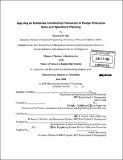Applying an enterprise architecting framework to design enterprise sales and operations planning
Author(s)
Chu, Brandon B
DownloadFull printable version (9.703Mb)
Other Contributors
Leaders for Manufacturing Program.
Advisor
Deborah J. Nightingale and Roy E. Welsch.
Terms of use
Metadata
Show full item recordAbstract
Raytheon Company, a leader in aerospace and defense, has experienced tremendous growth through mergers and acquisitions. In particular, the company's Space and Airborne Systems (SAS) business unit was largely formed through acquisitions of E-Systems and Texas Instruments and a merger with Hughes Aircraft Company. To assimilate the legacy organizations, Raytheon and SAS have undertaken great efforts to work as "One Company." One such example has been to strive for an enterprise sales and operations planning process. Five years ago, Raytheon Space and Airborne Systems (SAS) Operations leaders recognized the need to be more proactive in comprehending forecasted business and subsequent impacts to SAS' manufacturing network. As a result, Program Requirements and Operations Planning (PROP) was born to enable improved supply chain planning for factory labor and capital resources. Over time, the complexity of SAS' business has proven to be a challenge for PROP to achieve its intended objectives.- This thesis considers PROP as an enterprise rather than a process and proposes re-designing it using a holistic enterprise architecting framework including a thorough examination of the current state of PROP with respect to seven architectural views (strategy, policy/external factors, process, organization, knowledge, IT, and products/services). A future state PROP design is derived from the analysis and then validated against a detailed case study of the Army's Firefinder radar product line manufactured at Raytheon's Forest, Mississippi facility.
Description
Thesis (M.B.A.)--Massachusetts Institute of Technology, Sloan School of Management; and, (S.M.)--Massachusetts Institute of Technology, Engineering Systems Division; in conjunction with the Leaders for Manufacturing Program at MIT, 2008. Includes bibliographical references (p. 63).
Date issued
2008Department
Leaders for Manufacturing Program at MIT; Massachusetts Institute of Technology. Engineering Systems Division; Sloan School of ManagementPublisher
Massachusetts Institute of Technology
Keywords
Sloan School of Management., Engineering Systems Division., Leaders for Manufacturing Program.